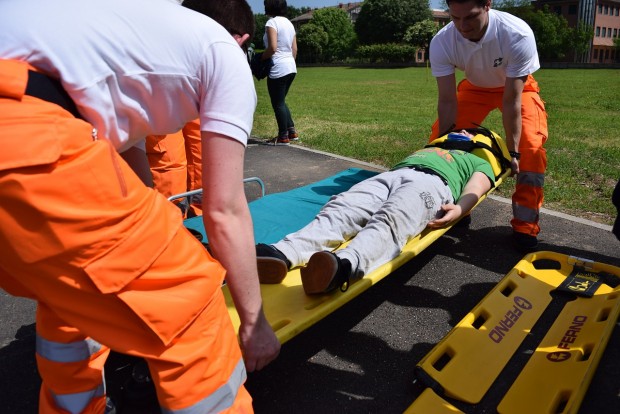Photo : How to become an Emergency Medical Technician
What is an emergency medical technician?
Emergency medical technicians (EMTs) or ambulance technicians are health care providers of emergency medical services. They are trained to respond quickly to emergencies regarding medical problems, traumatic injuries, and accidents. Emergency medical technicians typically respond to 911 calls and then transport the patients to a hospital after providing them with lifesaving first aid. They must work under immense pressure and are required to make life-saving decisions in a short amount of time. EMTs also work alongside other professionals such as the police, firefighters, paramedics, and doctors.
Emergency medical technicians (EMTs) are trained to carry out simple, non-invasive procedures to help save the patient's life.
The path to becoming an EMT
It usually takes 1-3 years to become an EMT, depending on one's career goals and educational path. Highlighted below are the educational steps to become an EMT:
1. Basic education:
In comparison to other health care positions, much less is required to get a job as an EMT. To become an EMT, the candidate must be 18 or above and must have a high school diploma or pass the GED exam to be eligible.
2. CPR certification:
Most EMT programs require the student to have a certificate in CPR-Basic life support issued by the American Heart Association or American Red Cross before applying. Several online and local organizations are available to give training for this certification.
3. Find an EMT program:
Aspiring EMTs must complete a state-approved education program and get a diploma in emergency medical technology to apply for certification. Students must make sure it is an accredited program like the Emergency Medical Services program in Florida at City College. In the state of Florida, training can be completed in a few as 27 months. Every state has an approved EMT course that meets the National Education Standards, and these courses can usually be finished in around two years.
4. NREMT examination:
After completing your state approved EMT course and getting a certificate in CPR, you can apply to take the National Registry Emergency Medical Technician or NREMT examination to get your national certification. The NREMT exam consists of 2 parts: a cognitive exam and a motor skills exam. The cognitive test is a computerized written exam that consists of 70-120 questions that are to be answered within 2 hours. The questions are from topics such as trauma, medical emergencies, airway management, ventilation, gynecology, cardiology, and EMS operations. In order to pass, candidates must achieve a "standard level of competency." In case of failure, the candidate can give a re-test after 15 days. The candidates have a total of 6 attempts to pass the computerized cognitive exam.
The practical examination tests the candidate's ability to deal with emergency and traumatic situations, for example, assessing the patient, controlling bleeding, managing fractures, joint dislocations, and immobilizing the spine. They will also be tested on how to handle medical emergencies like cardiac arrest, shock, stroke, etc.
The candidate can apply for the test by visiting the NREMT website to start their application process, and this must be done within two years of course completion.
5. Apply for a license:
In order to start practicing and apply for a job, you need to first apply for a license by completing an online form and submitting the required documents, which may vary according to where you live. To find out about licensing requirements, the candidate can contact the EMS agency within their state. The EMTs have to renew their license every two years for which they are required to complete a 30-hour refresher course.
6. Other requirements:
Other than the educational and certification requirements, there are some other skills that are necessary for a job like this. For example, the candidate must have a valid driver's license. Excellent communication and interpersonal skills to deal effectively with many different types of people is a must. To complete the certification process, the candidate will also go through a criminal background check. EMTs also need to be physically fit as they have to perform physically demanding jobs.
What will you learn:
In an EMT certificate program, the students are taught the basic life-saving procedures they will need in order to provide emergency medical care to patients on the way to the hospital. Students learn communication skills and how to assess and transport patients to the hospital. Along with classroom knowledge, they are also taught by hands-on simulations and experiences through labs and internships at trauma centers, ambulance services, and fire departments.
Programs:
● Anatomy and physiology
● Patient assessment
● How to care for injuries and medical conditions
● Internships for hands-on experience
The skills learned:
● How to respond to 911 calls
● Stabilizing and transferring the patient
● Managing airways
● Bandaging
● Documenting patient treatment
● Learning medical terminology
● Managing medical emergencies
● History taking
● Making patient assessments and deciding what care they need
Job opportunities
EMTs respond to 911 calls, then care for and transport the patients to the hospital in an ambulance. After obtaining experience and some additional training, many professionals pursue careers as advanced EMTs or paramedics. Others enter similar fields that require their existing skill set, for example, in the police, fire department, or ER medic/tech.
How much does an EMT earn?
The median annual salary for EMTs is $34,320 according to the U.S. Bureau of Labor Statistics.
Most EMTs work full time, and some may work more than 40 hours in one week. Since EMTs must be available to work during emergencies, they may have to work night shifts and on weekends. Work as an EMT is physically and mentally strenuous, and sometimes involves life and death situations. To be able to deal with such working conditions, the EMT must be physically fit, focused, and mentally strong. They should remain rational and compassionate while communicating with patients and dealing with emergency situations.
* This is a contributed article and this content does not necessarily represent the views of universityherald.com









